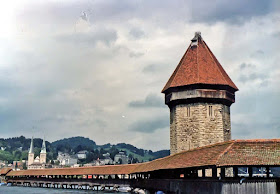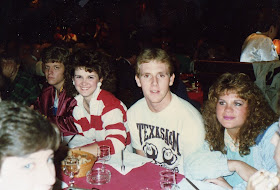From Paris in 1987, we bussed our way into Switzerland. This section of the trip was breathtaking, with the Swiss Alps and the pastoral scenes outside the windows. The air was so fresh and clean and cool.
Still sporting the Paris shirt and hat, Diana and I enjoy a much more spacious room than in London or Paris.
We were outside of Lucerne in a smaller town whose name I cannot place. The hotel was situated above the town and the views were spectacular.
The scenery on the way to Lucerne (bus window reflection).
Lucerne itself was a day trip. The city's founding dates back to the 10th century. The most famous landmark is the Chapel Bridge, dating from 1333. A few years after I visited, a discarded cigarette destroyed the majority of the structure, which has since been replaced. The tower along the bridge is a 13th century fortification. At the far end you can see the Church of Saint Leodeger, dating from 1633.
The town straddles the Reuss River and much of the eating and dining is alongside the water. It's a beautiful town.
In the center of town is main shopping mall, pedestrian only, with its immaculately swept cobblestones and flags.
The Jesuit Church (Jesuitenkirche) is the baroque building with the two spires you see on the left in the picture below
Much of the oldest part of the city still features the half-timbre and painted architecture from the 1600s.
The evening before we were headed to Austria, we were bussed to a music hall where I ate fondue for the first time and drank (quite legally thank you very much). However, 20 Texas teenagers given free alcohol all evening (was there a limit? the details were fuzzy the next day, much less 20 years after the fact) meant the "culture" we were supposedly soaking up wasn't getting much attention. I do remember being absolutely mesmerized by the floating sensation walking to the bathroom and then the automatic toilet seat protectors that moved around the seat when you flushed. Ah, memories of Europe.
Since this post is entirely about Switzerland and technically the hangover story is all about getting stuck on a bus travelling into Austia, we'll just skip over that part.
***************************************
1988
We stayed in a different small town outside Lucerne on the second trip, with even more majectic scenery. I spent the night sleeping on the balcony under the toasty down comforter in the reclining chair.
More Old Town Lucerne
The Bourbaki Panorama
Depicting the crossing of the haggard French troops into the safety of Switzerland during the Franco-Prussian war, these massive paintings form a circle into which the visitor stands surrounded by the scene.
The Lion of Lucerne, a memorial to the fallen Swiss soldiers in the French Revolution at the storming of the Tuileries palace in the Insurrection of August 10, 1792 where they had been guarding the Royal family.
The Lion lies in his lair in the perpendicular face of a low cliff — for he is carved from the living rock of the cliff. His size is colossal, his attitude is noble. His head is bowed, the broken spear is sticking in his shoulder, his protecting paw rests upon the lilies of France. Vines hang down the cliff and wave in the wind, and a clear stream trickles from above and empties into a pond at the base, and in the smooth surface of the pond the lion is mirrored, among the water-lilies.
Around about are green trees and grass. The place is a sheltered, reposeful woodland nook, remote from noise and stir and confusion — and all this is fitting, for lions do die in such places, and not on granite pedestals in public squares fenced with fancy iron railings. The Lion of Lucerne would be impressive anywhere, but nowhere so impressive as where he is. ~Mark Twain, A Tramp Abroad, 1880
Around about are green trees and grass. The place is a sheltered, reposeful woodland nook, remote from noise and stir and confusion — and all this is fitting, for lions do die in such places, and not on granite pedestals in public squares fenced with fancy iron railings. The Lion of Lucerne would be impressive anywhere, but nowhere so impressive as where he is. ~Mark Twain, A Tramp Abroad, 1880
The inscription reads Helvetiorum Fidei ac Virtuti ("To the loyalty and bravery of the Swiss"). The dying lion has been impaled by a spear, as a lays across the French shield, while nearby another shield bears the Swiss coat of arms. Beneath are listed the names of the officers and the total number of dead (760) and survivors (350).
Thorvaldsen, the sculptor, was shortchanged, but instead of ruining the monument, out of respect for the dead soldiers, he changed the shape of the nook into the silhouette of a pig.





























No comments:
Post a Comment